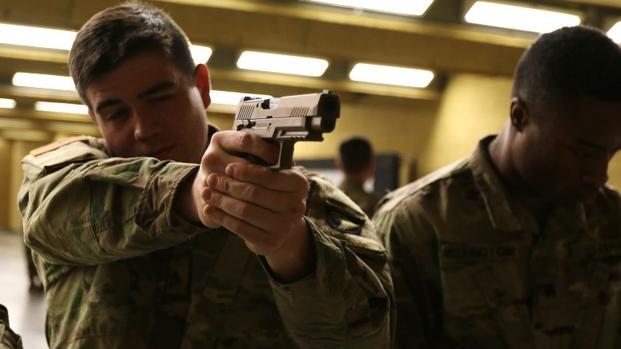U.S. Army weapons officials have begun fielding the new Modular Handgun System under a plan to issue the service's new sidearm all the way down to the team-leader level.
Soldiers from the 101st Airborne Division (Air Assault) at Fort Campbell, Kentucky began receiving the new XM17 MHS on Monday and spent time shooting the new pistol today, according to Lt. Col. Martin O'Donnell, a spokesman for the 101st Airborne.
The 101st received more than 2,000 MHSs on Nov. 17 and plan to field the new pistols over the next year, O'Donnell said.
Army Chief of Staff Gen. Mark Milley and Sen. Tom Cotton, R-Arkansas, attended the initial MHS fielding to about 25 soldiers from the 1st Battalion, 506th Infantry Regiment, O'Donnell said.
The Army awarded Sig Sauer a contract worth up to $580 million Jan. 19. Sig Sauer beat out Glock Inc., FN America and Beretta USA, maker of the current M9 9mm service pistol, in the competition for the Modular Handgun System, or MHS, program.
The 10-year agreement calls for Sig to supply the Army with full-size XM17 and compact XM18 versions of its 9mm pistol. MHS comes with Tritium sights as well as 17 and 21-round magazines.
One of the challenges of fielding the MHS will be to develop a new training program since the current plan calls for issuing the XM17 to squad leaders and team leaders, a significant change to a policy that excluded junior leaders from carrying M9s.
"The 101st has realized that this weapon is going into a lot more hands than ... what we are authorized to have as equipment," said Sgt. 1st Class Andrew Flynn, the master gunner for the 101st Airborne.
"This weapon is going to go down to the team leader, which is not what we typically have in the 101st or across most light divisions."
The expanded policy will apply to all Army units receiving the MHS, Debra Dawson, spokeswoman for Program Executive Office Soldier told Military.com.
In addition to a standard operator's course, "we are going to do an additional course which is basically teaching that soldier how to transition from that pistol to his M4 and the M4 to his pistol," Flynn said, adding that the 101st is also planning to increase pistol marksmanship training.
"We are putting this weapon into the hands of a lot of younger soldiers who have never fired it," he said.
First Lt. Andrew Borer said "today is a pretty awesome day" after shooting the new MHS.
"The weapon itself is a very simple handgun; it's a very easy handgun to shoot," Borer said. "There is little to no resistance on the trigger. ... It's a very easy weapon to regain our sight picture with and to aim and fire the weapon once we have put a round down range."
Cpl. Jory Herrmann, a team leader in C Company, said it was a great experience being of the first units to fire the MHS.
"It handled really well, very reliable," he said. "We slung a lot of rounds down range today had little to no problems out of them. ... I think it is going to be a great side arm."
Herrmann said he was excited about the plan to issue the MHS to team leaders, like himself.
"In the heat of the fight it will give you an opportunity to maybe change up your tactics," Herrmann said. "It will give us more choices, more options ... which is great for a team leader."
As far as the current M9 pistols, "the Army has decided that in order to maintain that lethality and ensure that everybody has what they need, we are going to maintain the 9mm Berettas until all units have qualified on MHS, Flynn said.
-- Matthew Cox can be reached at matthew.cox@military.com.












